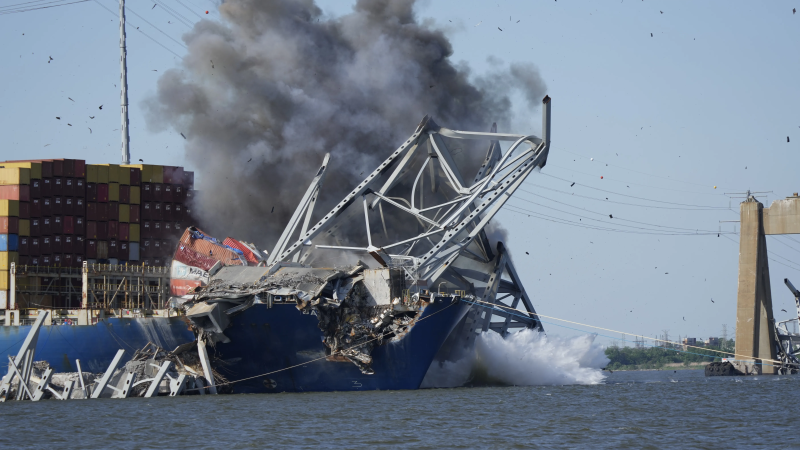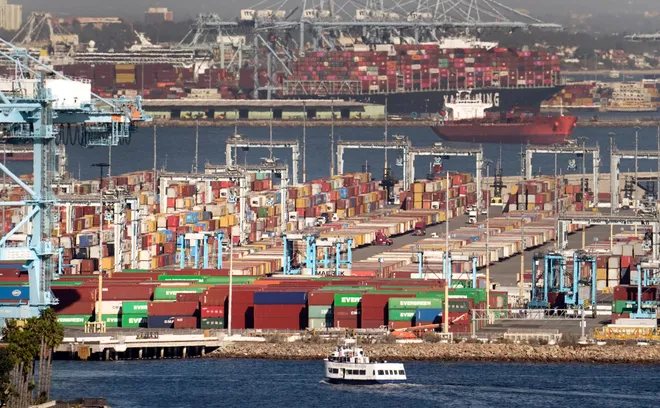Port workers strike could snarl the supply chain and bust your holiday budget
(This story was updated to add new information.)
Americans could face high prices and shortages again this holiday season but this time, it would be because of a worker strike instead of a global pandemic.
As of Thursday, the International Longshoremen’s Association (ILA) said labor talks with the United States Maritime Alliance (USMX) remain at a standstill, and about 45,000 of its union workers at 36 East coast and Gulf Coast ports are ready to walk on Oct. 1 for the first time since 1977.
A strike could lead to shortages of certain items and boost prices for voters already frustrated with housing and food inflation, experts said. The ports handle about half of U.S. ocean imports, including food, clothing, auto parts, cars shipped via container and holiday toys, experts said.
“A supply chain disruption would undoubtedly lead to price increases across the board and would impact consumers’ ability to find the toys they are looking for in the weeks and months ahead,” said Greg Ahearn, president and chief executive of The Toy Association.
Capitalize on high interest rates: Best current CD rates
Diversification didn’t work
After clogged post-pandemic ports on the West Coast kept more than 150 container ships waiting to dock in February 2022, according to the Department of Transportation, companies began shipping more of their wares through the East Coast and Gulf Coast ports, experts said.
Simultaneously, to cut their reliance on China, which was slow to reopen and faced more intense government scrutiny after the pandemic, companies began sourcing from different countries, especially southeast Asia, said Chris Tang, distinguished professor at the University of California, Los Angeles who specializes in supply chain management.
Many companies shipping goods from southeast Asia use East Coast ports because they’re closer, he said.
“Because of these changing dynamics, the East Coast (strike) impact is more pronounced,” Tang said.
What products will be affected?
Aside from holiday goods, experts said other items that may experience shortages and higher prices include:
- Seafood, like cod fish from Iceland or Canada and shrimp from Thailand and Ecuador. “Those aren’t as easy to transport by train because they’re refrigerated and perishable,” Tang said. “And air ship is very expensive.”
- Electronics, like cell phones and computers, now come from southeast Asian nations like Vietnam, Indonesia, and Thailand instead of China and are routed through East Coast ports, Tang said.
- Pharmaceuticals, although these are easier “to ship by air because they are a higher value product, but there could be drug shortages if negotiations can’t be settled within a month or so,” Tang said.
- Cars and auto parts. The Port of Baltimore, Maryland, leads the nation in car shipments. European cars come through this port and may experience a shortage, experts said. Auto parts from Europe often pass through East Coast and Gulf Coast ports, too.
- Machinery parts. The East Coast ports also surpass others in the U.S. in shipments of machinery, fabricated steel and precision instruments, according to S&P Global Market Intelligence.
- Bananas. Three-quarters of the nation’s bananas enter through East Coast and Gulf Coast ports, said Jason Miller, interim chair of Michigan State University's department of supply chain management. “There is (zero) chance of shifting all these imports through the West Coast, and the low dollar value per unit of weight for bananas means putting them on planes isn’t economical,” he wrote in a LinkedIn post. “Moreover, you can’t frontload a perishable product.”

Can companies reroute shipments?
Jonathan Gold, vice president of supply chain and customs policy for the National Retail Federation trade group, said some companies prepared early by:
- Taking cargo in earlier than normal
- Rerouting some shipments to West Coast ports
However, those steps are limited. “Retailers can’t bring everything in,” he said.
Some companies may face inventory space constraints, while perishable food products and other goods don’t have any good alternative routes, Tang said. The Panama Canal operations are recovering from droughts, Red Sea ships have been attacked by Houthi rebels, and the Cape of Good Hope takes much longer, he said.
Besides, “given the long lead time for toy products, significant quantities are already in transit with shipping logistics having been in place for months,” Ahearn said. “This makes it extremely difficult to rework scheduled shipments or product already undefined to the U.S. market through the East Coast or Gulf ports.”
Flashback:Black October is here: Transport delays, labor shortages slow supply chain as holiday shopping begins
If there’s a strike, length is important
The period that follows a strike can also be disruptive, some experts said.
“It’s not just about shut down but also about the recovery period, and how long it takes to get things up back and running,” Gold said.
Generally, one strike day would take three to five days to catch up, and “the longer the strike goes, the more that’s compounded,” he said.
“In 2002, when we had an 11-day lockout on the West Coast because of labor negotiations, that cost (the economy) a billion dollars a day and took six months to recover and get stuff out,” Gold said. “Trade is higher now than in 2002 so it could take even longer.”
Back then, the Bush administration invoked the Taft-Hartley Act to force the ports to reopen. The Act allows the federal government to seek a court injunction against a strike to allow both parties to continue negotiations during an 80-day cooling off period.

Will the Biden administration help?
The Biden administration has declined to invoke the Taft-Hartley Act. Instead, White House officials encouraged ongoing discussions despite pleas for help from retail, agriculture, commerce, auto care, toy and other groups for months.
“It’s an election year so Biden may intervene to help (Democratic presidential nominee Kamala) Harris,” Tang said. “On the outside, he may not say it but behind the scenes, he might help negotiations because it’s important to Harris. Any chaos could affect the election.”
Characterizing US supply chains and the economy as "more resilient than they were when we came into office," White House spokesperson Robyn Patterson said, "the Supply Chain Disruptions Task Force is up and running – and is prepared to respond swiftly to help minimize potential disruptions in the event of a prolonged strike by engaging extensively with the ports, state and local officials, industry, labor, ocean carriers, rail and trucking companies."
No matter what, the story ends with higher prices
If port workers strike, Americans may see price increases soon, experts said.
If port workers agree to a deal, “labor costs go up,” Tang said. “So down the road, consumers still pay a higher price. Consumers will have to learn to adjust and adapt, but unfortunately, things will be more expensive.”
Medora Lee is a money, markets, and personal finance reporter at USA TODAY. You can reach her at mjlee@usatoday.com and subscribe to our free Daily Money newsletter for personal finance tips and business news every Monday through Friday morning.
Disclaimer: The copyright of this article belongs to the original author. Reposting this article is solely for the purpose of information dissemination and does not constitute any investment advice. If there is any infringement, please contact us immediately. We will make corrections or deletions as necessary. Thank you.







